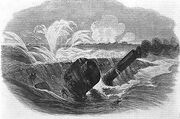
Sinking of USS Tecumseh, 1864.
CANONICUS class MONITORS (1864)
Built: Jersey City, New Jersey; Boston, Massachusetts; Wilmington, Delaware.
Commissioned: April to September, 1864
Service: Various
Home Port: Various
Dimensions: 223' Length, 43'4" Beam, 13'6". (Canonicus and Saugus were slightly longer, at 235x43'8)
Armor: 11" iron Turret and Pilothouse; 5" iron Hull, 1.5" iron Deck.
Armament: 2x15" Smoothebores
Engines: Single Screw
Speed: 8 Knots
Crew: 85
Fate: Served during the American Civil War and the Spanish American War. Most survived to be scrapped. Tecumseh was sunk by torpedo (mine) at Mobile Bay in August, 1864.
Summary
The Canonicus class was the final evolution of the basic monitor design that directly descended from the namesake for the entire family of vessels, USS Monitor . While they had been planned as early as 1862, what were intended as slightly improved Passaic class monitors were considerably modified by want of the fact that the Passaics were beginning to provide after-action reports at the same time that the first ships in the class were being laid down, with the end result that their completion was delayed, with only five of the ships laid down being completed in time to see service before the end of the American Civil War. However, all would eventually be completed, and most would see service during the Spanish-American War of 1898. It is worth noting that the ships not completed by the end of the war were mostly being built at inland ports, such as Cincinnati.
The Canonicus Class was an enlarged design, with a shape and form better suited to oceangoing travel; they were intended for speeds of up to 18 Knots, and while this proved impossible upon completion, they were regarded by some as being the most seaworthy of the single turret monitors laid down during the war. In addition, the Canonicus class vessels were completed with iron bottom hulls, after the experience of wooden bottomed monitors in encountering river obstructions, and Confederate torpedoes.
The five ships completed before the end of the war were Canonicus, Manhattan, Mahopac, Saugus, and Tecumseh. They saw active, heavy service throughout the last two years of the war, most notably in support of the US Army, and at the Battles of Fort Fisher and Mobile Bay . Tecumseh was the only member of the class to be sunk by enemy action during the war. She struck a torpedo (mine) upon entering Mobile Bay and went down within thirty seconds, taking her entire crew with her. Manhattan, accompanying her along with two Milwaukee class twin-turreted Monitors (Chickasaw and Winnebago) continued on to fight in the bitterly contested Battle of Mobile Bay, principally against CSS Tennessee II and her attendant vessels.
After the war, most of the Canonicus class vessels were laid up briefly, but continued to to be reactivated in various roles, including that of coastal defense during the Spanish-American War of 1898, when an attack on the US Eastern Seaboard by the Spanish Navy was a serious threat. In addition, two of the vessels in the class - Catawba and Oneota, were sold to the Peruvian Navy in 1868 and saw a very active service life. There is a very rare film of Canonicus underway in 1907 for the Jamestown Exposition. Canonicus had been decommissioned in 1877, but ironically was the oldest surviving member of the class, and the last American Civil War era warship to be disposed of by the US Navy.